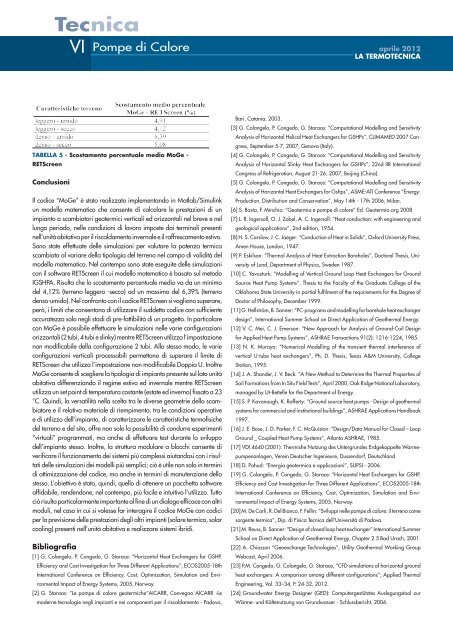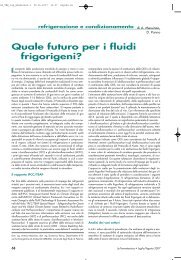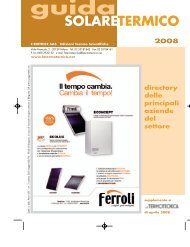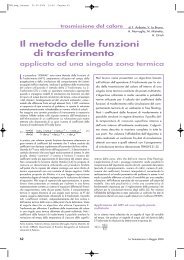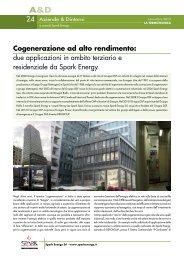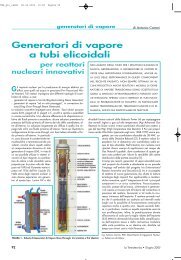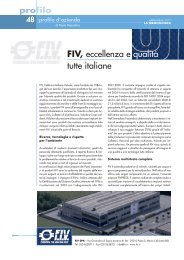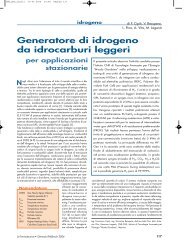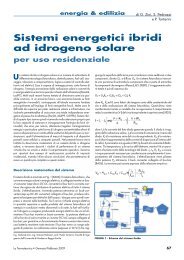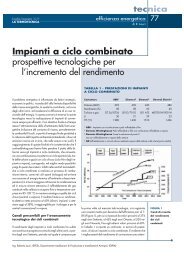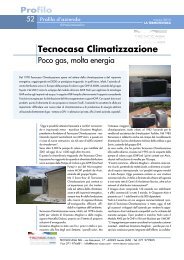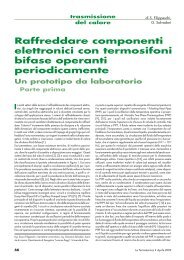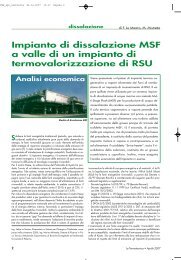Articolo scaricabile gratuitamente in PDF (1268 Kb) - La Termotecnica
Articolo scaricabile gratuitamente in PDF (1268 Kb) - La Termotecnica
Articolo scaricabile gratuitamente in PDF (1268 Kb) - La Termotecnica
Create successful ePaper yourself
Turn your PDF publications into a flip-book with our unique Google optimized e-Paper software.
Tecnica<br />
VI<br />
Pompe di Calore<br />
aprile 2012<br />
LA TERMOTECNICA<br />
TABELLA 5 - Scostamento percentuale medio MoGe -<br />
RETScreen<br />
Conclusioni<br />
Il codice “MoGe” è stato realizzato implementando <strong>in</strong> Matlab/Simul<strong>in</strong>k<br />
un modello matematico che consente di calcolare le prestazioni di un<br />
impianto a scambiatori geotermici verticali ed orizzontali nel breve e nel<br />
lungo periodo, nelle condizioni di lavoro imposte dai term<strong>in</strong>ali presenti<br />
nell’unità abitativa per il riscaldamento <strong>in</strong>vernale e il raffrescamento estivo.<br />
Sono state effettuate delle simulazioni per valutare la potenza termica<br />
scambiata al variare della tipologia del terreno nel campo di validità del<br />
modello matematico. Nel contempo sono state eseguite delle simulazioni<br />
con il software RETScreen il cui modello matematico è basato sul metodo<br />
IGSHPA. Risulta che lo scostamento percentuale medio va da un m<strong>in</strong>imo<br />
del 4,12% (terreno leggero -secco) ad un massimo del 6,39% (terreno<br />
denso-umido). Nel confronto con il codice RETScreen si vogliono superare,<br />
però, i limiti che consentono di utilizzare il suddetto codice con sufficiente<br />
accuratezza solo negli stadi di pre-fattibilità di un progetto. In particolare<br />
con MoGe è possibile effettuare le simulazioni nelle varie configurazioni<br />
orizzontali (2 tubi, 4 tubi e sl<strong>in</strong>ky) mentre RETScreen utilizza l’impostazione<br />
non modificabile della configurazione 2 tubi. Allo stesso modo, le varie<br />
configurazioni verticali processabili permettono di superare il limite di<br />
RETScreen che utilizza l’impostazione non modificabile Doppia U. Inoltre<br />
MoGe consente di scegliere la tipologia di impianto presente sul lato unità<br />
abitativa differenziando il regime estivo ed <strong>in</strong>vernale mentre RETScreen<br />
utilizza un set po<strong>in</strong>t di temperatura costante (estate ed <strong>in</strong>verno) fissato a 23<br />
°C. Qu<strong>in</strong>di, la versatilità nella scelta tra le diverse geometrie dello scambiatore<br />
e il relativo materiale di riempimento, tra le condizioni operative<br />
e di utilizzo dell’impianto, di caratterizzare le caratteristiche termofisiche<br />
del terreno e del sito, offre non solo la possibilità di condurre esperimenti<br />
“virtuali” programmati, ma anche di effettuare test durante lo sviluppo<br />
dell’impianto stesso. Inoltre, la struttura modulare a blocchi consente di<br />
verificare il funzionamento dei sistemi più complessi aiutandosi con i risultati<br />
delle simulazioni dei modelli più semplici; ciò è utile non solo <strong>in</strong> term<strong>in</strong>i<br />
di ottimizzazione del codice, ma anche <strong>in</strong> term<strong>in</strong>i di manutenzione dello<br />
stesso. L’obiettivo è stato, qu<strong>in</strong>di, quello di ottenere un pacchetto software<br />
affidabile, rendendone, nel contempo, più facile e <strong>in</strong>tuitivo l’utilizzo. Tutto<br />
ciò risulta particolarmente importante al f<strong>in</strong>e di un dialogo efficace con altri<br />
moduli, nel caso <strong>in</strong> cui si volesse far <strong>in</strong>teragire il codice MoGe con codici<br />
per la previsione delle prestazioni degli altri impianti (solare termico, solar<br />
cool<strong>in</strong>g) presenti nell’unità abitativa e realizzare sistemi ibridi.<br />
Bibliografia<br />
[1] G. Colangelo, P. Congedo, G. Starace: “Horizontal Heat Exchangers for GSHP.<br />
Efficiency and Cost Investigation for Three Different Applications”, ECOS2005-18th<br />
International Conference on Efficiency, Cost, Optimization, Simulation and Environmental<br />
Impact of Energy Systems, 2005, Norway.<br />
[2] G. Starace: “Le pompe di calore geotermiche“AICARR, Convegno AICARR -Le<br />
moderne tecnologie negli impianti e nei componenti per il riscaldamento - Padova,<br />
Bari, Catania, 2003.<br />
[3] G. Colangelo, P. Congedo, G. Starace: “Computational Modell<strong>in</strong>g and Sensitivity<br />
Analysis of Horizontal Helical Heat Exchangers for GSHPs”, CLIMAMED 2007 Congress,<br />
September 5-7, 2007, Genova (Italy).<br />
[4] G. Colangelo, P. Congedo, G. Starace: “Computational Modell<strong>in</strong>g and Sensitivity<br />
Analysis of Horizontal Sl<strong>in</strong>ky Heat Exchangers for GSHPs”, 22nd IIR International<br />
Congress of Refrigeration, August 21-26, 2007, Beij<strong>in</strong>g (Ch<strong>in</strong>a).<br />
[5] G. Colangelo, P. Congedo, G. Starace: “Computational Modell<strong>in</strong>g and Sensitivity<br />
Analysis of Horizontal Heat Exchangers for Gshps”, ASME-ATI Conference “Energy:<br />
Production, Distribution and Conservation”, May 14th - 17th 2006, Milan.<br />
[6] S. Basta, F. M<strong>in</strong>chio: “Geotermia e pompe di calore” Ed. Geotermia.org 2008<br />
[7] L. R. Ingersoll, O. J. Zobel, A. C. Ingersoll: “Heat conduction: with eng<strong>in</strong>eer<strong>in</strong>g and<br />
geological applications”, 2nd edition, 1954.<br />
[8] H. S. Carslaw, J. C. Jaeger: “Conduction of Heat <strong>in</strong> Solids”, Oxford University Press,<br />
Amen House, London, 1947.<br />
[9] P. Eskilson: “Thermal Analysis of Heat Extraction Boreholes”, Doctoral Thesis, University<br />
of Lund, Department of Physics, Sweden 1987.<br />
[10] C. Yavuzturk: “Modell<strong>in</strong>g of Vertical Ground Loop Heat Exchangers for Ground<br />
Source Heat Pump Systems”, Thesis to the Faculty of the Graduate College of the<br />
Oklahoma State University <strong>in</strong> partial fulfilment of the requirements for the Degree of<br />
Doctor of Philosophy, December 1999.<br />
[11] G. Hellström, B. Sanner: “PC-programs and modell<strong>in</strong>g for borehole heat exchanger<br />
design”, International Summer School on Direct Application of Geothermal Energy.<br />
[12] V. C. Mei, C. J. Emerson: “New Approach for Analysis of Ground-Coil Design<br />
for Applied Heat Pump Systems”, ASHRAE Transactions 91(2): 1216-1224, 1985.<br />
[13] N. K. Muraya: “Numerical Modell<strong>in</strong>g of the transient thermal <strong>in</strong>terference of<br />
vertical U-tube heat exchangers”, Ph. D. Thesis, Texas A&M University, College<br />
Station, 1995.<br />
[14] J. A. Shonder, J. V. Beck: “A New Method to Determ<strong>in</strong>e the Thermal Properties of<br />
Soil Formations from In Situ Field Tests”, April 2000, Oak Ridge National <strong>La</strong>boratory,<br />
managed by Ut-Bettelle for the Department of Energy.<br />
[15] S. P. Kavanaugh, K. Rafferty: “Ground source heat pumps - Design of geothermal<br />
systems for commercial and <strong>in</strong>stitutional build<strong>in</strong>gs”, ASHRAE Applications Handbook<br />
1997.<br />
[16] J. E. Bose, J. D. Parker, F. C. McQuiston: “Design/Data Manual for Closed – Loop<br />
Ground _ Coupled Heat Pump Systems”, Atlanta ASHRAE, 1985.<br />
[17] VDI 4640 (2001): Thermishe Nutzung des Untergrundes Erdgekoppelte Warmepumpenanlagen,<br />
Vere<strong>in</strong> Deutscher Ingenieure, Dussendorf, Deutschland<br />
[18] D. Pahud: “Energia geotermica e applicazioni”, SUPSI - 2006.<br />
[19] G. Colangelo, P. Congedo, G. Starace: “Horizontal Heat Exchangers for GSHP.<br />
Efficiency and Cost Investigation for Three Different Applications”, ECOS2005-18th<br />
International Conference on Efficiency, Cost, Optimization, Simulation and Environmental<br />
Impact of Energy Systems, 2005, Norway.<br />
[20] M. De Carli, R. Del Bianco, F. Fell<strong>in</strong>: “Sviluppi nelle pompe di calore: il terreno come<br />
sorgente termica”, Dip. di Fisica Tecnica dell’Università di Padova.<br />
[21] M. Reuss, B. Sanner: “Design of closed loop heat exchanger” International Summer<br />
School on Direct Application of Geothermal Energy, Chapter 2.5 Bad Urach, 2001.<br />
[22] A. Chiasson “Geoexchange Technologies”, Utility Geothermal Work<strong>in</strong>g Group<br />
Webcast, April 2006.<br />
[23] P.M. Congedo, G. Colangelo, G. Starace, “CFD simulations of horizontal ground<br />
heat exchangers: A comparison among different configurations”, Applied Thermal<br />
Eng<strong>in</strong>eer<strong>in</strong>g, Vol. 33–34, P. 24-32, 2012.<br />
[24] Groundwater Energy Designer (GED): Computergestütztes Auslegungstool zur<br />
Wärme- und Kältenutzung von Grundwasser - Schlussbericht, 2006.


